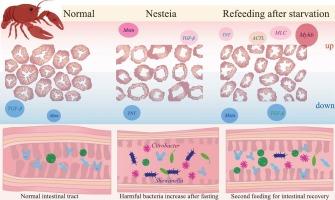Refeeding effects on physiological functions and gut microbiota composition in starved red swamp crayfish (Procambarus clarkii)
IF 2.2
2区 生物学
Q4 BIOCHEMISTRY & MOLECULAR BIOLOGY
Comparative Biochemistry and Physiology D-Genomics & Proteomics
Pub Date : 2025-09-23
DOI:10.1016/j.cbd.2025.101640
引用次数: 0
Abstract
This study investigated the effects of starvation and refeeding on physiological responses and gut microbiota composition in Procambarus clarkii. Four treatment groups were established: a regular feeding group (RF), a 6-day starvation followed by 6-day refeeding group (SF6), a 12-day starvation followed by 12-day refeeding group (SF12), and a continuous starvation group (NS). A total of 360 healthy juvenile crayfish with intact appendages and uniform body size (mean weight: 9.25 ± 0.05 g) were randomly allocated to the four groups, with three replicates per group and 30 individuals per replicate. The feeding trial lasted 24 days. Starvation followed by refeeding significantly improved growth performance, restored physiological functions, and enhanced digestive capacity. Starvation increased body moisture and ash content, while decreasing crude protein and lipid levels. Energy utilization during starvation followed a sequential depletion of glycogen, lipids, and proteins. Elevated SOD activity post-starvation indicated enhanced antioxidative defense against reactive oxygen species and lipid peroxidation. Moreover, starvation markedly upregulated the expression of TGF-β and Mstn, while refeeding—particularly in the SF6 group—led to higher expression levels of ACTL, TNT, Myhb, and MLC. Histological analysis revealed that starvation induced degeneration of intestinal villi, thinning of intestinal walls, and atrophy of R-cells in the hepatopancreas. 16S rRNA gene sequencing showed that starvation significantly reduced gut microbial diversity and richness, increased the relative abundance of Bacteroidota, Shewanella, and Citrobacter, and decreased the Firmicutes/Bacteroidota (F/B) ratio. In contrast, refeeding reversed these changes, enriching the microbiota with Firmicutes, Erysipelotrichaceae, Dysgonomonas, and Rhodobacter. In conclusion, starvation imposed significant physiological and microbial alterations in P. clarkii, including impaired growth traits and increased abundance of potentially pathogenic bacteria. However, refeeding effectively mitigated these effects, demonstrating the resilience of P. clarkii to nutritional stress.

再投喂对饥饿克氏原螯虾生理功能和肠道菌群组成的影响
本研究探讨了饥饿和复食对克氏原螯虾生理反应和肠道菌群组成的影响。设常规饲喂组(RF)、饥饿6 d后再饲喂组(SF6)、饥饿12 d后再饲喂组(SF12)和连续饥饿组(NS)。选取360只身体健康、附体完整、体型均匀(平均体重9.25±0.05 g)的小龙虾幼虾,随机分为4组,每组3个重复,每个重复30尾。试验期24 d。饥饿后再饲喂显著提高了生长性能,恢复了生理功能,增强了消化能力。饥饿增加了体内水分和灰分含量,降低了粗蛋白质和脂肪水平。饥饿期间的能量利用伴随着糖原、脂质和蛋白质的连续消耗。饥饿后SOD活性升高表明对活性氧和脂质过氧化的抗氧化防御能力增强。此外,饥饿显著上调TGF-β和Mstn的表达,而再喂食(尤其是SF6组)导致ACTL、TNT、Myhb和MLC的表达水平升高。组织学分析显示,饥饿引起肠绒毛变性,肠壁变薄,肝胰腺r细胞萎缩。16S rRNA基因测序结果显示,饥饿显著降低了肠道微生物的多样性和丰富度,增加了拟杆菌门(Bacteroidota)、希瓦氏菌门(Shewanella)和柠檬酸杆菌门(Citrobacter)的相对丰度,降低了厚壁菌门/拟杆菌门(Bacteroidota)的F/B比。相反,再饲喂逆转了这些变化,丰富了厚壁菌门、丹毒杆菌科、Dysgonomonas和Rhodobacter的微生物群。总之,饥饿对克氏假单胞菌造成了显著的生理和微生物变化,包括生长性状受损和潜在致病菌丰度增加。然而,重新喂食有效地减轻了这些影响,证明了克氏杆菌对营养压力的恢复能力。
本文章由计算机程序翻译,如有差异,请以英文原文为准。
求助全文
约1分钟内获得全文
求助全文
来源期刊
CiteScore
5.10
自引率
3.30%
发文量
69
审稿时长
33 days
期刊介绍:
Comparative Biochemistry & Physiology (CBP) publishes papers in comparative, environmental and evolutionary physiology.
Part D: Genomics and Proteomics (CBPD), focuses on “omics” approaches to physiology, including comparative and functional genomics, metagenomics, transcriptomics, proteomics, metabolomics, and lipidomics. Most studies employ “omics” and/or system biology to test specific hypotheses about molecular and biochemical mechanisms underlying physiological responses to the environment. We encourage papers that address fundamental questions in comparative physiology and biochemistry rather than studies with a focus that is purely technical, methodological or descriptive in nature.

 求助内容:
求助内容: 应助结果提醒方式:
应助结果提醒方式:


